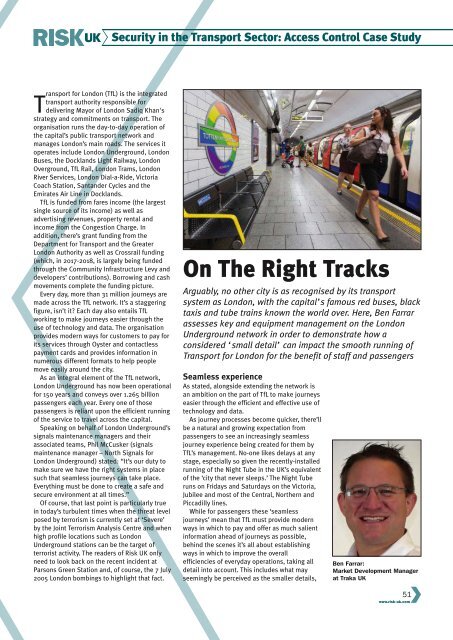RiskUKNovember2017
Create successful ePaper yourself
Turn your PDF publications into a flip-book with our unique Google optimized e-Paper software.
Security in the Transport Sector: Access Control Case Study<br />
Transport for London (TfL) is the integrated<br />
transport authority responsible for<br />
delivering Mayor of London Sadiq Khan's<br />
strategy and commitments on transport. The<br />
organisation runs the day-to-day operation of<br />
the capital’s public transport network and<br />
manages London’s main roads. The services it<br />
operates include London Underground, London<br />
Buses, the Docklands Light Railway, London<br />
Overground, TfL Rail, London Trams, London<br />
River Services, London Dial-a-Ride, Victoria<br />
Coach Station, Santander Cycles and the<br />
Emirates Air Line in Docklands.<br />
TfL is funded from fares income (the largest<br />
single source of its income) as well as<br />
advertising revenues, property rental and<br />
income from the Congestion Charge. In<br />
addition, there’s grant funding from the<br />
Department for Transport and the Greater<br />
London Authority as well as Crossrail funding<br />
(which, in 2017-2018, is largely being funded<br />
through the Community Infrastructure Levy and<br />
developers’ contributions). Borrowing and cash<br />
movements complete the funding picture.<br />
Every day, more than 31 million journeys are<br />
made across the TfL network. It’s a staggering<br />
figure, isn’t it? Each day also entails TfL<br />
working to make journeys easier through the<br />
use of technology and data. The organisation<br />
provides modern ways for customers to pay for<br />
its services through Oyster and contactless<br />
payment cards and provides information in<br />
numerous different formats to help people<br />
move easily around the city.<br />
As an integral element of the TfL network,<br />
London Underground has now been operational<br />
for 150 years and conveys over 1.265 billion<br />
passengers each year. Every one of those<br />
passengers is reliant upon the efficient running<br />
of the service to travel across the capital.<br />
Speaking on behalf of London Underground’s<br />
signals maintenance managers and their<br />
associated teams, Phil McCusker (signals<br />
maintenance manager – North Signals for<br />
London Underground) stated: “It’s our duty to<br />
make sure we have the right systems in place<br />
such that seamless journeys can take place.<br />
Everything must be done to create a safe and<br />
secure environment at all times.”<br />
Of course, that last point is particularly true<br />
in today’s turbulent times when the threat level<br />
posed by terrorism is currently set at ‘Severe’<br />
by the Joint Terrorism Analysis Centre and when<br />
high profile locations such as London<br />
Underground stations can be the target of<br />
terrorist activity. The readers of Risk UK only<br />
need to look back on the recent incident at<br />
Parsons Green Station and, of course, the 7 July<br />
2005 London bombings to highlight that fact.<br />
On The Right Tracks<br />
Arguably, no other city is as recognised by its transport<br />
system as London, with the capital’s famous red buses, black<br />
taxis and tube trains known the world over. Here, Ben Farrar<br />
assesses key and equipment management on the London<br />
Underground network in order to demonstrate how a<br />
considered ‘small detail’ can impact the smooth running of<br />
Transport for London for the benefit of staff and passengers<br />
Seamless experience<br />
As stated, alongside extending the network is<br />
an ambition on the part of TfL to make journeys<br />
easier through the efficient and effective use of<br />
technology and data.<br />
As journey processes become quicker, there’ll<br />
be a natural and growing expectation from<br />
passengers to see an increasingly seamless<br />
journey experience being created for them by<br />
TfL’s management. No-one likes delays at any<br />
stage, especially so given the recently-installed<br />
running of the Night Tube in the UK’s equivalent<br />
of the ‘city that never sleeps.’ The Night Tube<br />
runs on Fridays and Saturdays on the Victoria,<br />
Jubilee and most of the Central, Northern and<br />
Piccadilly lines.<br />
While for passengers these ‘seamless<br />
journeys’ mean that TfL must provide modern<br />
ways in which to pay and offer as much salient<br />
information ahead of journeys as possible,<br />
behind the scenes it’s all about establishing<br />
ways in which to improve the overall<br />
efficiencies of everyday operations, taking all<br />
detail into account. This includes what may<br />
seemingly be perceived as the smaller details,<br />
Ben Farrar:<br />
Market Development Manager<br />
at Traka UK<br />
51<br />
www.risk-uk.com

















